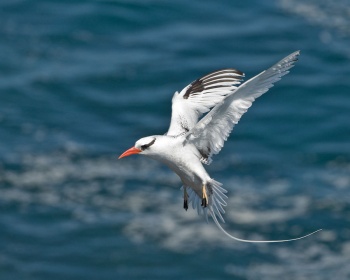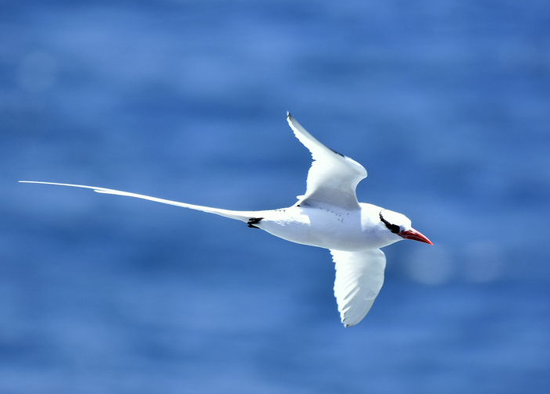Alternative name: Boatswain Bird
Includes: Arabian Tropicbird / Lesser Red-billed Tropicbird
- Phaethon aethereus
Identification
90–107 cm (35½-42 in), including tail streamers
Ws. 1m
- central tail feathers white, very long: can give bird total length of 96 cm
- upperside primary coverts and leading vanes of outer primaries black—giving a more or less solid black wedge at leading edge of wing
- rest of flight feathers white or with a pronounced black bar on the secondary coverts (indicus)
- back, mantle and lesser coverts with fine black or dark grey vermiculations on a white background
- eye patch black and usually pronounced (reduced in indicus). Tends to extend oliquely upwards behind the eye
- bill red, or ranging from pinky-orange to red (indicus)
Sexes are similar; males average longer-tailed
Juvenile
- tail streamers lacking
- back greyer
- bill yellow
Similar species
White-tailed Tropicbird and Red-tailed Tropicbird. White-tailed Tropicbird has white primary coverts on upperside and black eye line tends to turn down, not up.
Distribution

Photo © by bionicsherpa
South Plaza, Galapagos, Ecuador, March 2009
Found in tropical waters of the Atlantic Ocean, the north-west Indian Ocean and the eastern Pacific.
They breed in the Galapagos Islands, Ecuador, off the Pacific coast of Mexico, in the Caribbean, the Canary Islands, Spain, on islands in the southern Atlantic, and the Yemen, Oman and Saudi Arabian coasts.
Taxonomy
Subspecies indicus may be split as "Arabian Tropicbird" or "Lesser Red-billed Tropicbird", P. indicus based on plumage and vocal differences.
Subspecies
Clements recognises the following subspecies [1]:
- P. a. mesonauta: Subtropical and tropical eastern Pacific, Caribbean and eastern Atlantic
- P. a. aethereus: Fernando de Noronha, Ascension Island and St Helena (south Atlantic)
- P. a. indicus: "Arabian Tropicbird". Red Sea, Persian Gulf and Gulf of Aden. [The shortest tail of any tropicbird, rarely as long as the body. Bill often pinkish or orangy with black cutting edges. Secondary coverts with (second) black bar. Black eye patch generally much reduced. Back vermiculations heavy, pronounced.]
Habitat
Tropical islands, coastal cliffs and maritime.
Behaviour
Action
Reported to not be a good swimmer.
Breeding
They breed on tropical islands, laying a single egg on cliff ledges or on the ground.
Diet
They feed on fish and squid.
References
- Clements, J. F., T. S. Schulenberg, M. J. Iliff, D. Roberson, T. A. Fredericks, B. L. Sullivan, and C. L. Wood. 2017. The eBird/Clements checklist of birds of the world: v2017, with updates to August 2017. Downloaded from http://www.birds.cornell.edu/clementschecklist/download/
- BirdLife International
- Wikipedia
Recommended Citation
- BirdForum Opus contributors. (2025) Red-billed Tropicbird. In: BirdForum, the forum for wild birds and birding. Retrieved 26 April 2025 from https://www.birdforum.net/opus/Red-billed_Tropicbird
External Links
GSearch checked for 2020 platform.1






